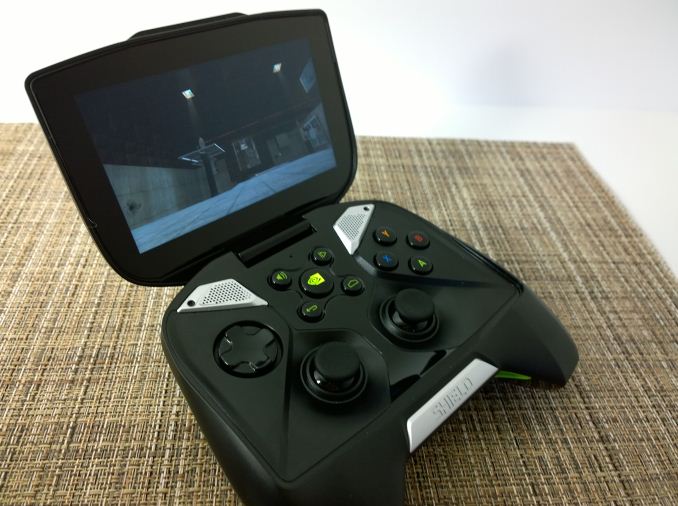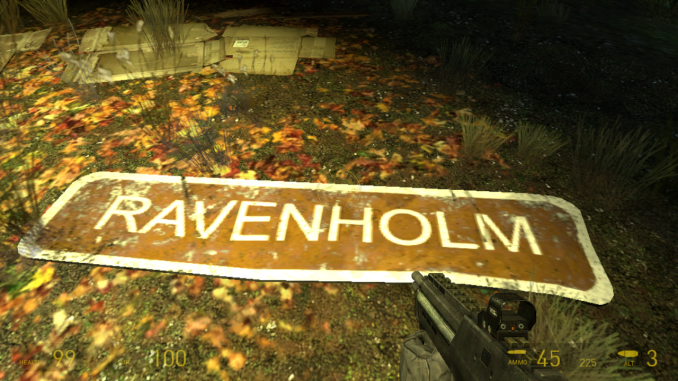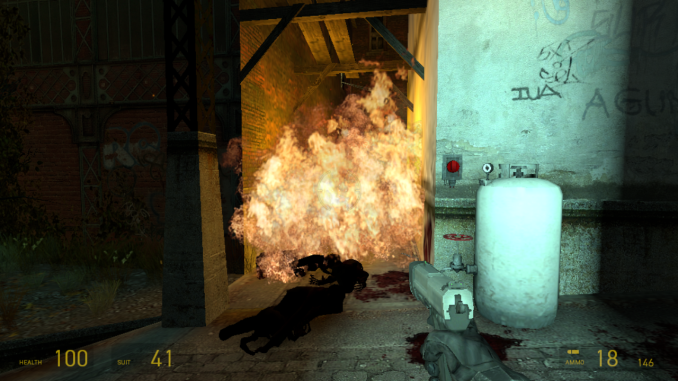Some Thoughts on Half-Life 2 and Portal on Shield
by Joshua Ho on May 22, 2014 10:35 PM EST- Posted in
- Smartphones
- Mobile
- Tablets
- Shield
- NVIDIA

If you talked to me seven years ago, the concept of phone games beyond Snake and basic flash games would've been beyond me. That wasn’t really on my mind, especially because playing games like Battlefield 2 effectively required a desktop. I did try it on a Dell XPS M170, with an Nvidia 7800 GTX graphics card, 1 GB of RAM, and a Pentium M processor, but even then, it was no guarantee that it would load the game consistently. Crashes to desktop were common because of the RAM requirements, and hitting the page file would cause frustrating freezes. Of course, things have completely changed since then. Mobile became one of the fastest growing sectors in the tech industry, 40-60mm thick, 14 pound laptops were no longer necessary to play games at acceptable IQ/FPS levels, and the slate-style smartphone has gone from distant curiosity to everyday necessity.
So the port of Half-Life 2 and Portal to the Shield was interesting, because I’ve seen the sheer breadth of experiences that Source can provide, from Resistance and Liberation to Nightmare House 2. Nvidia has stated that Half Life 2 on Android is a port of the Linux version with OpenGL support to OpenGL ES, and based upon a casual playthrough of both Half Life 2 and Portal, it’s not immediately obvious that there are any issues with the engine port itself. In fact, it runs quite well. When immersed in playing the game, the experience is incredible, especially compared to the experience that one usually gets on handheld consoles like the PS Vita and 3DS. While I was concerned that the control scheme would be difficult to adapt to as a PC gamer, it turns out that with auto-aim and some other compensation mechanisms that gameplay is perfectly workable. The one issue that I did have was targeting things like headcrabs in mid-air, as pixel-precise pointing still isn’t quite there for joystick control systems. Battery life was also great. I managed to go around four hours of nonstop gaming at a mid-level of brightness, although this is an extremely rough rule and can vary greatly. I hope to get more precise data on this soon.
Of course, the bigger question is how well it actually performs. While timedemo functionality can’t be accessed, video settings are locked out, and there’s no console access like in the PC versions, it’s still possible to gauge the approximate experience. Based upon a quick playthrough of Ravenholm, I managed to take a closer look at the FPS instead of relying purely upon subjective judgment. It turns out that there’s a pretty even distribution of FPS across the board from 20 FPS to 60 FPS. The median FPS was 43, and overall I’d say that it’s quite accurate, as in less intensive scenes it will stay capped at 60 but anything with effects such as fire and explosions will often cause the gameplay to stutter noticeably, as in the scene above. Portal was similar, but due to the relatively simple level design FPS remained higher in general. Overall, it appears that the CPU usually is only at around 50% utilization throughout the game, which is indicative that either the GPU is the limiting factor in performance of this game or that the engine is not well-threaded for the port. There was the possibility of thermal throttling, but unlikely because exhaust air temperatures weren’t hot enough for concern. Unfortunately, no data on battery voltage nor temperature is given by the Shield. Ultimately, while this is helpful information for someone that wants to buy the game, the real question is how well IQ and performance compare to PCs, and will require further investigation to get a rough idea of how well modern ARM SoCs compare with CPUs and GPUs from the 65-90nm era.












40 Comments
View All Comments
djgandy - Friday, May 23, 2014 - link
This is nonsense. The spread of devices you have all have different operating systems. Do they have to use OpenOS?Developers are not stupid and they know how to plan for multiple OS and graphics API's. The rendering back end for most titles is completely abstracted from the development of the content. The designing, implementing and testing of the game itself is far more complex and time consuming than choosing what graphics API to use.
If a game is for PC chances are they will always go the DX route because DX is far better supported on the PC. OpenGL by contrast is a mutt of an API with many versions and extensions with poor baseline support by all GPU vendors. It is a support nightmare. Still the rendering backend and DX interaction is all completely abstracted from the rest of the game.
And then there are engines, that a lot of people use, which mean they don't have to worry about writing all their own customer renderer. And guess what, the engines have multiple API backends too.
https://unity3d.com/
http://unigine.com/products/unigine/
grahaman27 - Friday, May 23, 2014 - link
unity uses opengl, thanks for the supporting evidence.opengl is gaining traction.
Jumangi - Saturday, May 24, 2014 - link
The main Gaming development API on Windows is still DirectX. The Xbox One is based on it too. The PlayStation 4 has a custom API made by Sony. OpenGL will forever be relegated to second tier just like Linux on the Desktop.kpxgq - Friday, May 23, 2014 - link
sounds great in theory but licensing and exclusive contracts will prevent that in practiceGuspaz - Friday, May 23, 2014 - link
Android doesn't use/support OpenGL, it uses OpenGL ES. They're not the same thing, and porting between them is more complex than a simple recompile.kron123456789 - Saturday, May 24, 2014 - link
Croteam have Android build that supports OpenGL 4.Guspaz - Saturday, May 24, 2014 - link
That's kind of irrelevant. You could do a custom build that supports D3D, but nobody is going to make software for it if only some niche custom build supports it.Stochastic - Friday, May 23, 2014 - link
This is a much more favorable assessment than that given by Eurogamer: http://www.eurogamer.net/articles/digitalfoundry-2...Dribble - Friday, May 23, 2014 - link
Think that review's a bit harsh. One step at a time here, before you couldn't play anything like this on a mobile device at all, tegra 4 gives you 2008 era gaming at lower settings. That's a big step forward. Next step is to equal 360/PS3 on a mobile device and tegra K1 must be getting pretty close to that.OrphanageExplosion - Friday, May 23, 2014 - link
The review isn't harsh at all when I can play HL2 on my Asus T100 Bay Trail tablet on mostly high settings at 1366x768 at 30-60fps (no AA though) with only the odd drop beneath 30fps.